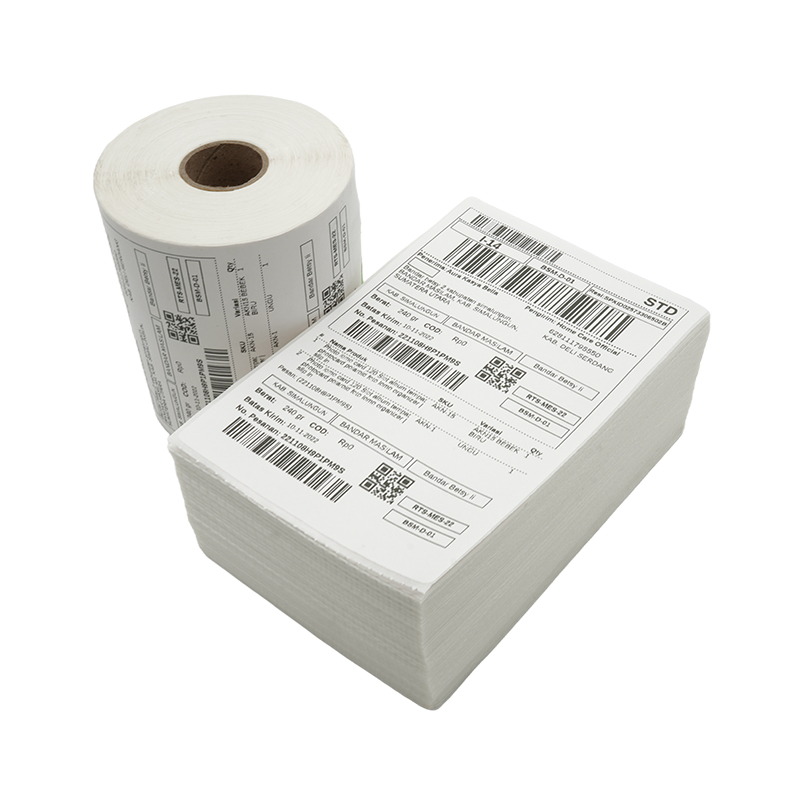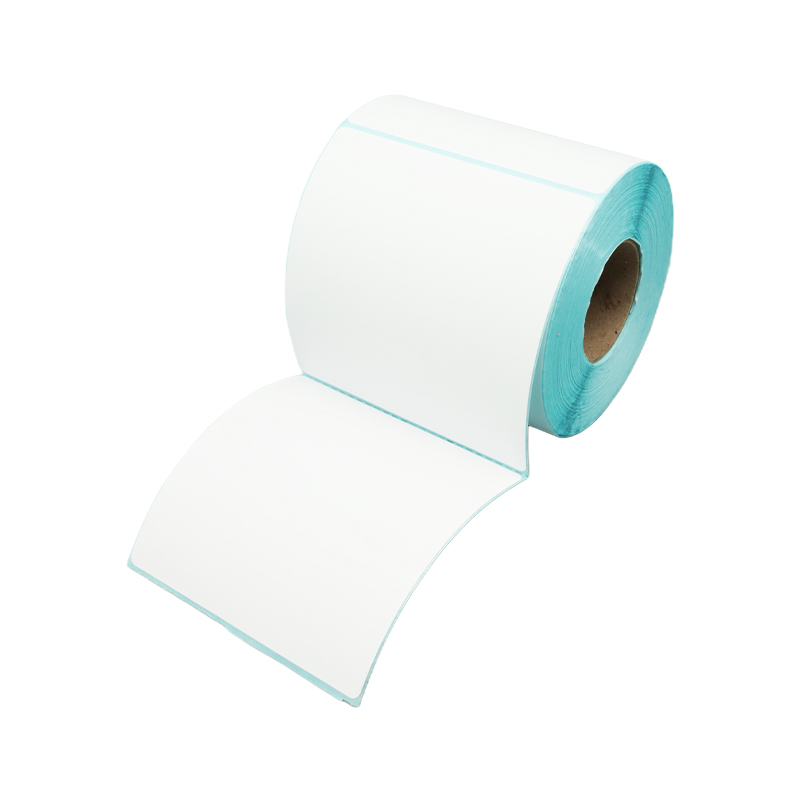Will it affect print clarity? Unveiling the true color development of blue grid thermal tag paper
Release Time : 2025-10-30
In modern office, warehouse management, production traceability, and equipment inspection scenarios, thermal label paper has become the preferred consumable for thermal printer users due to its advantages such as no need for ribbons, quiet printing, and low cost. Blue grid thermal tag paper is gradually gaining popularity—its light blue background is printed with fine coordinate grid lines, offering not only a clean visual experience but also auxiliary positioning and handwriting recording functions.
1. Color Development Mechanism: Heat-Driven, Unrelated to Background Color
The core principle of thermal printing is to activate the thermal coating on the label surface through localized heating of the print head, causing a chemical reaction that changes color. This coating mainly consists of leuco dyes, developers, and sensitizers, which rapidly generate a deep black substance when a critical temperature is reached, forming clear text, barcodes, or graphics. The entire process relies entirely on heat control and does not involve optical reflection or dye penetration. Therefore, as long as the thermal coating is uniform and intact, the color development effect mainly depends on the printing parameters, not the paper's background color. 1. The blue background serves only as a visual accent and does not interfere with the thermal reaction itself.
2. Structural Design: Scientific Separation of Blue and Thermal Layers
High-quality blue grid thermal tag paper employs a multi-layered composite structure to ensure a balance between functionality and printing performance. The blue layer is very thin and highly transparent, located beneath the thermal layer, serving only as a background color and not affecting heat conduction. More advanced products even utilize a "sandwich" design, encasing the blue layer between the substrate and the coating, further preventing direct contact between ink and the printhead. Therefore, when the printhead heats up, heat is efficiently transferred to the thermal layer, resulting in a clear black image, indistinguishable from a white label.
3. Grid Printing Process: Precise Control to Avoid Color Interference
The grid lines on the label are typically pre-printed using high-precision flexographic or offset printing processes, resulting in extremely fine lines with uniform spacing. Modern production processes strictly control ink thickness and drying levels to ensure the grid lines are flat and non-protruding, preventing uneven pressure on the printhead or localized overheating. More importantly, the ink used is non-thermal activated, meaning it won't change color or spread due to printing heat, thus avoiding the "gray background" or "blackened grid" phenomena. Users ultimately see clear black content superimposed on a blue grid background, with distinct visual layers and a 99.9% recognition rate from barcode scanners.
4. Actual Testing: Excellent Clarity and Contrast
In warehouse management systems, blue grid labels are commonly used for shelf identification, with grid lines assisting manual entry of location coordinates. In laboratories, they are used to record sample numbers and testing times, with the blue background enhancing readability. During equipment inspections, it facilitates the selection of inspection items. Extensive actual testing shows that, with correct printing density and speed settings, the text edges are sharp, barcodes have no broken lines, and QR code scanning is smooth, with no significant difference in clarity compared to standard white thermal paper. Even in strong light, the blue background reduces glare interference and improves human visual recognition.
In conclusion, blue grid thermal tag paper not only does not affect print clarity, but also enhances the practicality and aesthetics of the labels while ensuring excellent color rendering through scientific material structure and process design. Its blue background and grid lines serve both visual guidance and information organization functions, truly achieving "easy to use and beautiful to look at." With the increasing demand for intelligent management, these specialized labels, combining functionality and user-friendly design, are becoming a new standard for efficient office work and lean management.
1. Color Development Mechanism: Heat-Driven, Unrelated to Background Color
The core principle of thermal printing is to activate the thermal coating on the label surface through localized heating of the print head, causing a chemical reaction that changes color. This coating mainly consists of leuco dyes, developers, and sensitizers, which rapidly generate a deep black substance when a critical temperature is reached, forming clear text, barcodes, or graphics. The entire process relies entirely on heat control and does not involve optical reflection or dye penetration. Therefore, as long as the thermal coating is uniform and intact, the color development effect mainly depends on the printing parameters, not the paper's background color. 1. The blue background serves only as a visual accent and does not interfere with the thermal reaction itself.
2. Structural Design: Scientific Separation of Blue and Thermal Layers
High-quality blue grid thermal tag paper employs a multi-layered composite structure to ensure a balance between functionality and printing performance. The blue layer is very thin and highly transparent, located beneath the thermal layer, serving only as a background color and not affecting heat conduction. More advanced products even utilize a "sandwich" design, encasing the blue layer between the substrate and the coating, further preventing direct contact between ink and the printhead. Therefore, when the printhead heats up, heat is efficiently transferred to the thermal layer, resulting in a clear black image, indistinguishable from a white label.
3. Grid Printing Process: Precise Control to Avoid Color Interference
The grid lines on the label are typically pre-printed using high-precision flexographic or offset printing processes, resulting in extremely fine lines with uniform spacing. Modern production processes strictly control ink thickness and drying levels to ensure the grid lines are flat and non-protruding, preventing uneven pressure on the printhead or localized overheating. More importantly, the ink used is non-thermal activated, meaning it won't change color or spread due to printing heat, thus avoiding the "gray background" or "blackened grid" phenomena. Users ultimately see clear black content superimposed on a blue grid background, with distinct visual layers and a 99.9% recognition rate from barcode scanners.
4. Actual Testing: Excellent Clarity and Contrast
In warehouse management systems, blue grid labels are commonly used for shelf identification, with grid lines assisting manual entry of location coordinates. In laboratories, they are used to record sample numbers and testing times, with the blue background enhancing readability. During equipment inspections, it facilitates the selection of inspection items. Extensive actual testing shows that, with correct printing density and speed settings, the text edges are sharp, barcodes have no broken lines, and QR code scanning is smooth, with no significant difference in clarity compared to standard white thermal paper. Even in strong light, the blue background reduces glare interference and improves human visual recognition.
In conclusion, blue grid thermal tag paper not only does not affect print clarity, but also enhances the practicality and aesthetics of the labels while ensuring excellent color rendering through scientific material structure and process design. Its blue background and grid lines serve both visual guidance and information organization functions, truly achieving "easy to use and beautiful to look at." With the increasing demand for intelligent management, these specialized labels, combining functionality and user-friendly design, are becoming a new standard for efficient office work and lean management.







